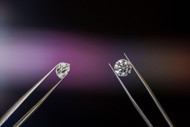How Are Lab Grown Diamonds Made? A Scientific Look Into the Process
Jul 5th 2023
Now couldn’t be a better time to shop for a more affordable alternative to naturally mined diamonds: lab diamonds. Mined diamonds and lab diamonds are identical both visually and chemically. This means lab grown diamonds are true diamonds — they just develop differently. If you were to put a real diamond beside a lab diamond today, even a trained gemologist may struggle to tell the difference between them without checking their certificates.
Let’s explore how lab created diamonds are made.
How Lab Grown Diamonds Are Made
The scientific process used to create lab diamonds mirrors the same process in which earth-mined diamonds naturally form. The difference? Natural diamonds take several billion years to form within the earth. Lab grown diamonds take just a few weeks in the laboratory setting.
Forming diamonds requires extreme pressure, carbon dioxide, and extreme heat. The pressure and heat affect the carbon dioxide, which is how lab grown diamonds are made.
A major benefit of lab diamonds is that they’re typically less expensive than natural diamonds. However, they don’t retain as much resale value as mined diamonds, so you may not be able to resell them as easily. On the contrary, a natural diamond retains some prestige and resale value, so you can resell it for a portion of its purchase price.
Two methods are used to produce lab created diamonds. The first is high pressure–high temperature, or HPHT. The second one is chemical vapor deposition, or CVD. Let’s examine these methods.

HPHT Method
Here’s a rundown of how lab grown diamonds are made using high pressure–high temperature.
This method begins with a small diamond piece called a seed. The seed is put in carbon and exposed to more than a million pounds/square inch of pressure and temperatures as high as 2700 degrees Fahrenheit. The pressure and heat melt the carbon layer and a diamond forms around the seed.
CVD Method
Let’s look at how lab created diamonds are made using chemical vapor deposition.
This method uses less pressure and heat than HPHT. Rather, a carbon-based gas mixture is used to create and grow a diamond. However, like with HPHT, the CVD process starts with a seed.
With the CVD technique, hydrogen and methane are introduced to a chamber containing the seed. Then, the space is heated, reaching hundreds of degrees Celsius, and the hydrogen and methane break down. Their carbon atoms start to form around the seed.
As you explore how lab grown diamonds are made, note that CVD is less costly and newer than HPHT. However, the diamonds created using CVD may look brown or black, in which case they must undergo HPHT to become colorless.
Shop Lab Ground Diamonds at EX3 Diamond Today
At EX3 Diamond, we’re a leading online provider of lab grown diamond jewelry. We offer engagement rings, wedding bands, earrings, bracelets, necklaces, and rings. All of our diamonds have the same composition, brilliance, and weight as an earth-mined diamond.
Explore our vast jewelry collection, and order your favorite lab created diamond pieces today!

